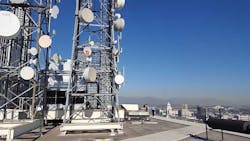Faster wireless is the future of American technology. Emerging technologies like autonomous cars, augmented reality, artificial intelligence and the Internet of Things all need fast wireless connectivity, and need it everywhere.
Help is on the way in the form of 5G, the next-generation wireless standard being developed by the telecom industry. The arrival of 5G is expected to bring widespread disruption of American business, as low-latency connections enable new services.
“This isn’t about improving phones. 5G is about going beyond the phone,” said Colby Synesael, Managing Director and Senior Research Analyst at Cowen & Co., who has been closely tracking the technology. “It’s about creating opportunities for the wireless network. We think 5G will bring the original vision of Big Data to fruition.”
Understanding 5G and its development timeline is important to the data center industry, as the arrival of faster connectivity will impact our nation’s Internet infrastructure. Most importantly, 5G will enable new data-intensive services like autonomous vehicles, which are untenable with current wireless connectivity. If 5G succeeds, it will be easier to move data between locations, a trend that has always been good for the data center business.
5G will require new transmission infrastructure, including thousands of cell towers and tens of thousands of antenna – known as small cells and DAS (distributed antenna systems) – that will be deployed on utility poles and other urban infrastructure. It will need fiber – LOTS of fiber.
It will also require new standards. Technically, 5G doesn’t exist yet. The standard for 5G is currently being developed by the 3rd Generation Partnership Project (3GPP), a collaboration between major global telecom standards groups. In March the group agreed to accelerate its process to enable standards-compliant testing of 5G in 2019 instead of 2020. Some major players aren’t waiting, and are already deploying networks billed as early versions of 5G.
More Bandwidth, Speed and Connections
So what exactly is 5G? Synesael says 5G technology will have three key attributes:
- High-bandwidth mobile broadband of 100 Mbps or better
- Support for massive machine-to-machine (M2M) communications, with density of up to 100,000 connections per square kilometer.
- Ultra low-latency communications, enabling sub-10 millisecond latency for mission-critical apps.
It will be deployed over a number of years, spreading as standards are finalized and the buildout of fiber, tower and antenna infrastructure is completed. “5G is an evolution, not like flipping a switch,” said Mobeen Khan, VP of Industrial IoT Solutions at AT&T. “It will happen in stages of technology rollout and coverage rollout.”
As 5G is deployed, it promises to have a transformational impact on data delivery to phones and devices, which currently rely on WiFi for about two-thirds of their data access.
“The Internet of Things is requiring us to make information available anywhere, at any time, through any device,” said Ilissa Miller, President of NEDAS (Northeast DAS and Small Cell Association), which sponsored several discussions of 5G at its recent New York conference. “We have to be able to access that information through our data plans, not just WiFi.”
Architecting the Future
How can entire industries be banking on a technology that hasn’t yet been defined, much less deployed at great expense? The consensus for 5G is broad, motivated by mobile broadband’s power to transform the U.S. economy and drive innovation and business growth.
“This is about architecting the future,” writes Aicha Evans, Senior VP and General Manager of the Communications and Devices Group at Intel. “As mobility evolves beyond the smartphone, 5G is becoming one of the most impactful technology transformations we are likely to see in our lifetimes. It will deliver next-generation experiences including autonomous driving, smart cities, the Internet of Things and, of course, the era of machines.”
Telecom carriers are expected to invest up to $5 billion in 5G technology, even before the 5G standard is approved. The industry’s willingness to invest heavily in 5G is clear in several recent moves by Verizon:
- In May Verizon prevailed over AT&T in several rounds of bidding, finalizing a deal to acquire Straight Path Communications for $3.1 billion – a 150 percent premium to the company’s stock price prior to the bidding war. Straight Path was a little-known company with a huge asset: lots of millimeter wave spectrum that can support new 5G offerings.
- In April, Verizon announced plans to purchase $1.05 billion worth of fiber from Corning over the next three years to “reinvent” its fiber backbone ahead of 5G deployments.
- In February, Verizon competed its $1.8 billion purchase of XO Communications fiber-optic network business, while leasing 5G spectrum from XO affiliate NextLink Wireless (with an option to buy NextLink).
“We are investing in the future,” said Nicola Palmer, Chief Network Officer at Verizon Wireless. “We have access to 28 GHz and 39 GHz spectrum that we will use for 5G. And the fiber we acquired through our XO and Corning transactions are enhancing our current networks with a keen eye toward future needs.”
Cowen analyst Synesael says Verizon’s commitment will drive similar investments by its wireless competitors, as well as cable companies whose premium on-demand content offerings are more vulnerable to “over the top” competitors broadcasting over ultra-fast wireless. including Netflix, Amazon and AT&T, .
“We’ve taken the view that (5G) will be successful, based on how much Verizon is investing in this,” said Synesael. “Cable companies like Comcast and Charter will have to have a wireless strategy. The competitive playing field will be the flattest it’s ever been.”
Infrastructure Implications for Data Centers
Synesael says that 5G will be “the first G built with the cloud in mind.” An example: The sub-10 millisecond latency envisioned for 5G is currently only available to high frequency trading operations. By comparison, 4G LTE has latency of 50-100 milliseconds. “That’s the difference between a car stopping on a dime or stopping in 20 feet,” he said. “This is going to be an instantaneous network.”
“With the reduced latency, the cloud moves closer to the edge, and you’re much more likely to use the cloud,” said Steve Brown, the former Chief Evangelist and Futurist at Intel, and now CEO at Bald Futurist. “I would contend that we’ll see an explosion of endpoints. The workload growth the data center community is facing is enormous. You have a big challenge, but it’s an exciting one.”
This brief video from IEEE Spectrum reviews some of the infrastructure technologies that will likely play a role in 5G deployments.
Network-rich data centers, such as interconnection colo centers and carrier hotels, figure to see more demand, serving as meeting points for new network infrastructure.
“The reality is that 5G will be a much more radio dense system than its predecessors,” said Jim Poole, Vice President of Ecosystem Development for Equinix, which operates a network of colocation facilities at key network intersections. . “Much more infrastructure must be deployed in the field. I can now deploy a CRAN and run an entire metro from a carrier neutral data center.”
A CRAN is a Cloud-Radio Access Network (or sometimes Centralized RAN), which uses new topologies and virtualization to reduce the cost and power draw of the network infrastructure.
Equinix isn’t the only data center player eyeing opportunities to host CRANs. This is also a growth area for Digital Bridge, which has pushed into the data center sector with its acquisitions of DataBank and Vantage Data Centers. Digital Bridge also is an investor in wireless companies, including telecom tower operator Verical Bridge and ExteNet systems, which provides wireless connectivity through distributed antenna systems (DAS), small cells,
DAS and small cells figure to be key benefactors from the growth of 5G. We’ll examine that in the next article on our series on 5G wireless.
About the Author


